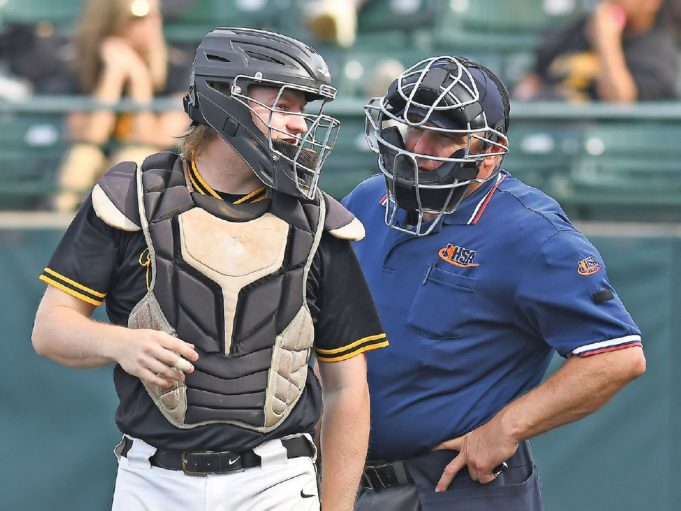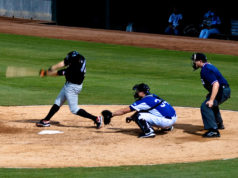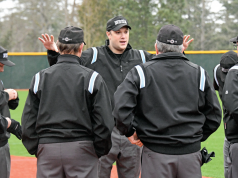Every umpire will encounter pitchers who aren’t happy with him or her. I had a generous strike zone, but even so a pitcher would occasionally register his disapproval of a call. What should we do about this? I’m not talking about the guy who throws a complete fit, because that’s easy. Goodbye. Instead, I mean the one who stares in at me, shakes his head, slaps his glove at the catcher’s return throw and the like.
I had very few ejections in my career and tried to walk away from volatile situations, but I would not tolerate this kind of behavior. Depending on how agitated the pitcher was I might let him off the hook once. Not twice. If I let Sam do this it’s likely to get worse, and teammate Joe will infer that he can act up as well. Then opponent Bill might wonder why he should behave if Sam and Joe aren’t. So I have to nip this in the bud.
The question is how, and I say it depends. There are unique factors at work from youth baseball through high school and college ball that dictate different approaches.
Let’s start with youth baseball, whether it’s Little League, travel ball or somewhere in between. Pitchers are wilder, so more pitches will be out of the strike zone. Umpires working this level often have not yet mastered the zone, so the odds of missing calls are greater. Given their immaturity, pitchers are more prone to blame us for their shortcomings and show disapproval, verbally and/or visibly, when calls don’t go their way. It’s also harder for us to confront them directly, for we can come across as bullies if we scold little Johnny or Susie.
When I had problems with pitchers at this level, I involved the head coach. At the time said coach might not be crazy about me either, but I didn’t care because all I wanted was for the pitcher to quit showing me up. I thought that because the coach is in charge of the team, my best bet, even if I felt he was clueless, was to give him the first crack at solving my problem. Coming across as reasonable and non-confrontational also earned me brownie points with everyone.
I would call the coach out of the dugout — don’t go over there, because entering “their territory” seems aggressive — and ask the coach to help me out by settling the pitcher down. If the coach tried to fight me I’d observe that it would be better for everyone if we went this route because otherwise I’d have to take matters in my own hands, and most likely no one would be happy if I did that. Putting the ball squarely in the coach’s court in this manner almost always produced good results. On very rare occasions it didn’t and I had no choice but to toss the pitcher and/or the coach.
As we move into high school and college, pitchers are older, more mature and generally have been in the game long enough to know not to show up an umpire. Problems still occur, but when they do we can deal with them more directly and, if necessary, frankly than in youth ball. But it still behooves us to get across our message in a non-confrontational manner that we’re not going to put up with nonsense. Back in the day we could shrink the strike zone or jerk off our mask and storm out to the mound, but this stuff doesn’t fly in today’s era.
I’ve known umpires who gave catchers a pregame sermon that they need to catch, not umpire, so don’t turn around on a call, etc. A few had similar chats with pitchers. I never did this because I thought it started things on a bad note to appear to be going into the game expecting trouble; instead, I worked on the theory that players’ behavior would be fine until they demonstrated otherwise.
College and even high school catchers are mature enough that I could use them to send a message to a pitcher whose gestures indicated his displeasure with me. (I tried this in youth ball, but he got halfway to the mound, turned around and yelled, “What did you want me to tell him?” Never again.) I may, for example, whisper in his ear, “I’m not putting up with your buddy’s nonsense, so go out there and straighten him out.” I didn’t use profanity or make threats because I knew this could come back to haunt me; anyway, I figured they were perceptive enough to read between the lines.
The catcher might be as upset with me as the pitcher is, but in my experience almost all were sensible enough to know that starting a war with me was not a good move so they stifled their feelings and got their pitcher to settle down. So, problem solved, without World War III being declared.
Having myself toiled on the mound and been upset with umpires (especially if I was having a bad day and wanted to use them as scapegoats), I appreciated those who handled me in this unobtrusive way. When an umpire comes on strong with a player it’s easy for him to get defensive and want to fire back, but it’s hard to do that when the umpire takes the subtle approach. A couple of times I didn’t calm down and he had to take care of business, but I knew I had only myself to blame. As an umpire, that’s the thought process I want pitchers to go through.
If my “messenger” approach didn’t work, I would take (not jerk) off my mask, walk in front of the plate (not storm out), put up my hand and tell him (not yell and point) to settle down. Doing this in a stern, but not aggressive, manner usually produced results. At these levels the players’ egos aren’t so fragile that they’ll crack if we confront them directly and they’re old enough that we won’t come across as bullies. Often the direct approach just works best.
If all else fails, we’ve no option but to resort to ejection. In high school ball I first opted to involve the head coach, just like youth ball, because the players’ maturity is such that I still wanted him as the go-between. Not in college. And if we get to the point of ejection, it will, if we’ve played our cards right, be obvious to everyone that we had no other choice.
What's Your Call? Leave a Comment:
Note: This article is archival in nature. Rules, interpretations, mechanics, philosophies and other information may or may not be correct for the current year.
This article is the copyright of ©Referee Enterprises, Inc., and may not be republished in whole or in part online, in print or in any capacity without expressed written permission from Referee. The article is made available for educational use by individuals.


















